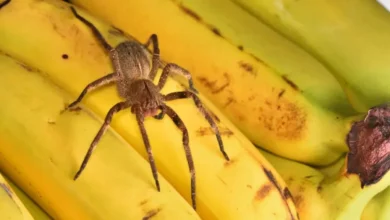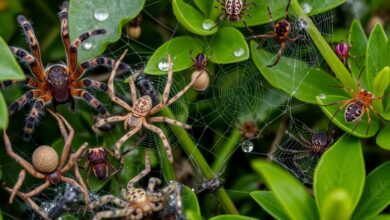Recluse Spider: Facts and Safety Tips for You
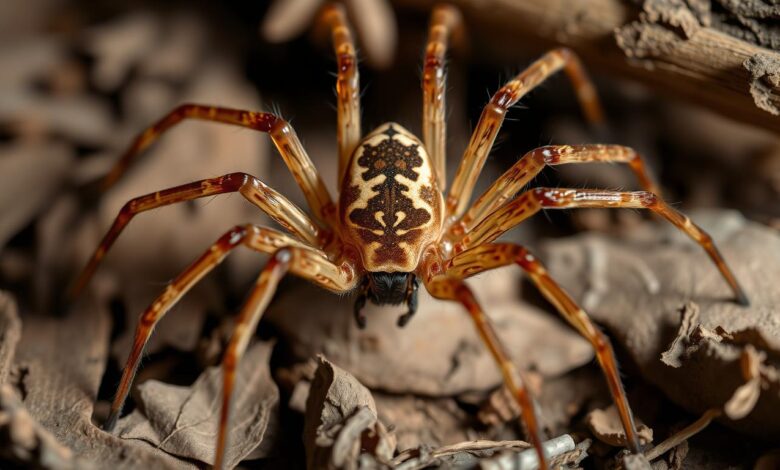
Recluse spiders, also known as brown recluse or violin spiders, are venomous arachnids. They can be a big threat to human health. These spiders have a unique violin-shaped marking on their body and like to hide in quiet spots.
Knowing the facts about recluse spiders and following important safety tips can keep you and your family safe. This guide will cover everything you need to know about these spiders. It will help you identify, prevent, and handle encounters with them.
Identifying the Recluse Spider
Appearance and Physical Characteristics
The recluse spider, known as Loxosceles, has a light brown color and a violin-shaped mark on its cephalothorax. This is the front part of its body where the legs attach. They are usually 6 to 20 millimeters long and have long, thin legs.
Unlike most spiders, recluse spiders have only six eyes. Their legs are covered in fine hairs, and their abdomen is oval-shaped without any distinct markings.
Distinguishing the Recluse from Other Spiders
Recluse spiders look similar to some common household spiders, but they have unique features. The most obvious is the violin-shaped mark on the cephalothorax. They also have only six eyes, unlike most spiders.
Their long, thin legs and light brown color make them stand out. These traits help you tell them apart from other spiders in homes and gardens.

| Characteristics | Recluse Spider | Other Spiders |
|---|---|---|
| Body Length | 6-20 mm | Varies by species |
| Eye Count | 6 eyes | 8 eyes |
| Cephalothorax Marking | Violin-shaped | No distinct marking |
| Leg Appearance | Long, thin, and hairy | Varies by species |
| Body Color | Light brown | Varies by species |
The Dangers of the Recluse Spider
The recluse spider is a medically significant spider because of its venom. Its bite can cause severe tissue damage and, in rare cases, life-threatening issues. The bite is often painless at first. But, within hours, it can become red, swollen, and painful, showing a bull’s-eye pattern.
About 4-6% of recluse spider bites can cause necrosis. There are around 1000 reported cases of severe envenomation from recluse spider bites each year. Luckily, the mortality rate from recluse spider bites is less than 1%.
Venomous Bite and Its Effects
In severe cases, the recluse spider venom can cause tissue necrosis. This means the skin and tissue under it start to die. It can lead to open sores, skin ulcers, and, in rare cases, systemic reactions that may need hospital care. The brown recluse bite symptoms can be very severe, and the fiddleback spider danger should not be ignored.
- Percentage of confirmed recluse spider bites leading to minor symptoms: 90%
- Percentage of bites occurring indoors: 70-80%
- Percentage of bites occurring while consumer clothing or shoes: 50%
It’s important to know about necrotic spider bites and the dangers of the recluse spider. By understanding the risks and taking precautions, you can prevent and handle any recluse spider encounters.
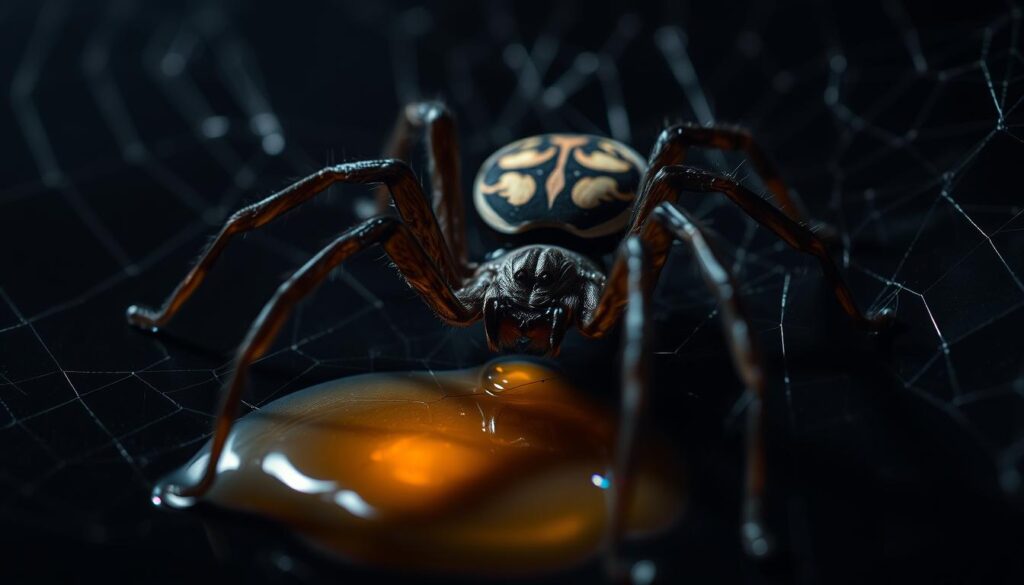
Habitat and Behavior of Recluse Spiders
Recluse spiders, also known as the fiddleback spider or brown recluse, live in dry, dark places. They like cracks, crevices, and secluded spots. These include closets, attics, basements, and woodpiles.
These spiders are mostly active at night. They use their speed to catch insects and small invertebrates. They are not usually aggressive and only bite when they feel threatened.
Knowing where and how recluse spiders live and behave is key to a safe home. This knowledge helps you avoid them and reduce the risk of their venomous bites.
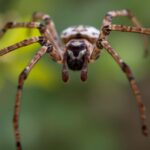 How many legs do spiders have?
How many legs do spiders have?
Recluse spiders are not something to worry about, but they do need caution. By understanding their habits and being careful, you can live safely with them.
recluse spider: Where They Are Found
The where are recluse spiders found question leads to the brown recluse. This spider is well-known and found mainly in the south-central United States. This area, from Texas to Ohio and Nebraska to Georgia, is where they are most common.
The fiddleback spider location has also grown. These spiders are now found in more parts of the country. While the south-central states are their main home, they have also been spotted in Arkansas, Kansas, Missouri, Oklahoma, and Tennessee. Here, they have formed large populations.
Geographic Distribution in the United States
The brown recluse is found mainly in these areas:
- Texas
- Oklahoma
- Kansas
- Missouri
- Arkansas
- Tennessee
- Ohio
- Nebraska
- Georgia
The brown recluse range is mostly in the south-central states. But, the fiddleback spider location has grown. Now, they are found in other parts of the United States too.
Preventing Recluse Spider Infestations
To keep recluse spiders out of your home, start by checking your home’s exterior. Look for cracks and gaps around windows, doors, and pipes. Use caulk or sealants to seal these openings. This will block their way into your home.
Sealing Entry Points and Reducing Clutter
Sealing entry points is just the beginning. It’s also important to keep your home tidy. Make sure storage areas, basements, and attics are clean and organized. Avoid leaving piles of boxes or clothes, as these can attract spiders.
To keep brown recluse spiders away, also take care of your landscaping. Trim bushes and shrubs that touch your house. This will stop spiders from using them as a bridge. You can also use diatomaceous earth or essential oils to repel them.
By following these steps, you can lower the chance of a recluse spider infestation. Keeping your home clean and safe is crucial. Remember, prevention is the best way to deal with these dangerous spiders.
What to Do If You Encounter a Recluse Spider
Seeing a recluse spider in your home can be scary. But, it’s important to stay calm and act wisely. These spiders, also known as brown recluse or fiddleback, are usually not aggressive. However, their venom can be dangerous if they bite you.
Safe Removal and Precautions
Don’t try to touch or kill the spider. This could make it bite you in defense. Use a broom, dustpan, or long tool to carefully move it into a sealed container. Then, take it outside and let it go in a place far from your home.
- Wear protective gloves to minimize the risk of a bite.
- Avoid sudden movements that could startle the spider and provoke a defensive response.
- If the spider is in a hard-to-reach area, consider contacting a professional exterminator who can safely and effectively remove it.
By following these steps, you can safely get rid of a recluse spider. Remember, these spiders are not usually aggressive. They like to stay away from people. So, the best thing to do is to stay calm and carefully remove the spider.
Treating Recluse Spider Bites
If you think you’ve been bitten by a recluse spider, get medical help right away. Even if it doesn’t hurt at first, the venom can cause serious damage. Sometimes, doctors need to step in to manage the effects.
Here’s what to do if you’ve been bitten by a recluse spider:
- Wash the affected area with soap and water to clean the wound.
- Apply a cool compress to the bite site to reduce swelling and inflammation.
- Watch the bite for signs of necrosis (tissue death) or other symptoms like nausea, vomiting, muscle pain, or severe reactions.
In some cases, the venom may need medical treatment. This could include corticosteroids or antibiotics to handle the damage. If you have severe symptoms, go to the emergency room right away. Quick and proper treatment can prevent serious problems from a recluse spider bite.
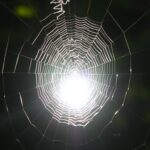 Amazing Properties of Spider Silk
Amazing Properties of Spider Silk
Knowing what to do if bitten by a recluse spider, brown recluse bite treatment, and fiddleback spider bite first aid is key. By following these steps and getting medical help when needed, you can avoid serious health issues.
| Spider | Venom Effects | Fatality Risk |
|---|---|---|
| Goliath Birdeater | Painful bite, but not medically significant | No known human fatalities |
| Sydney Funnel-web | Potentially deadly neurotoxin | Historically responsible for 13 confirmed deaths, but no fatalities since antivenom development |
| Black Widow | Severe pain, muscle cramps, nausea, and mild paralysis | Rare fatalities with effective treatment |
| Chilean Recluse | Necrosis and severe tissue damage | Severe complications in around 3-4% of cases |
| Brazilian Wandering | Severe pain and systemic effects | A few reported fatalities, especially in children, but antivenom is effective |
| Redback | Severe pain, muscle weakness, nausea, and respiratory failure | No known human fatalities |
| Six-eyed Sand | Believed to cause hemorrhaging, blood clotting, and significant tissue damage | Lack of antivenom makes it potentially deadly |
| Katipo | Severe pain, muscle cramps, and systemic symptoms similar to black widow | Fatalities are rare |
Myth-Busting: Common Misconceptions
Despite the dangers of recluse spiders, many myths surround them. One myth is that recluse spider bites cause most necrotic skin infections. However, most cases are not from spider bites. Another myth says brown recluse spiders are aggressive and seek out humans. But, they are actually quite docile and only bite when threatened.
Some also think fiddleback spiders can jump or fall from above. But, they can’t do that. Knowing the truth can help us not be too scared when we see recluse spiders.
- The recluse spider is not responsible for most necrotic skin infections, contrary to popular belief.
- Brown recluse spiders are generally docile and only bite in self-defense, not because they are aggressive.
- Fiddleback spiders cannot jump or drop from above, despite some misconceptions.
By understanding recluse spiders better, we can handle them without fear. This way, we can respond wisely when we see them, not based on myths.
Natural Repellents and Home Remedies
Some people prefer natural ways to keep recluse spiders away. Essential oils like peppermint, eucalyptus, and tea tree oil can keep spiders out. You can also use diatomaceous earth, a powder made from fossils, to block their path.
Essential Oils and Other Deterrents
Other natural ways include using vinegar, cayenne pepper, or citrus peels in spider-prone spots. These methods can help keep your home spider-free in a safe and green way.
- Peppermint oil – Repels spiders with its strong scent
- Eucalyptus oil – Keeps spiders away with its unique smell
- Tea tree oil – Keeps spiders from entering your home
- Diatomaceous earth – A natural powder that blocks spiders
- Vinegar – Repels spiders by messing with their scent signals
- Cayenne pepper – Spiders don’t like its strong smell and taste
- Citrus peels – The smell of lemons, limes, or oranges keeps spiders away
When to Call a Professional Exterminator
While you can handle small recluse spider problems on your own, sometimes you need a pro. If you see more recluse spider activity at home, or think there’s a big problem, call a pest control service. They have the skills and tools to get rid of recluse spiders safely.
Experts know how to find and get rid of recluse spiders without risks. If someone in your family is allergic to their venom, it’s safer to let a pro handle it. This keeps everyone safe from potential health issues.
When looking for a recluse spider exterminator or brown recluse pest control, choose a trusted company. They should have experience with fiddleback spider removal service. They’ll figure out how bad the problem is, make a plan, and get rid of the recluse spiders for you.
- Specialized knowledge and tools for effective recluse spider removal
- Reduced risk of bites and health complications for those with sensitivity
- Comprehensive treatment plan tailored to your specific infestation
Don’t ignore a recluse spider problem. Keep your home and family safe by calling the experts when needed.
| Reason to Call a Professional Exterminator | Benefit |
|---|---|
| Significant increase in recluse spider activity or sightings | Thorough identification and elimination of the infestation |
| Suspected larger recluse spider infestation | Specialized knowledge and tools for effective removal |
| Known sensitivity or allergy to recluse spider venom | Ensure safety during the treatment process |
Staying Vigilant: Routine Inspections
It’s important to stay alert and check your home often for recluse spiders. Look for these spiders in places where they like to hide. This helps prevent and manage infestations.
Checking Common Hiding Spots
Start by checking dark corners, storage areas, attics, and basements. These are favorite spots for brown recluse spiders and fiddleback spiders. Look for signs like old spider skins, webs, or the spiders themselves.
Be careful when moving things in these spots. Recluse spiders might be hiding. Quick action can keep your home safe from these dangerous spiders.
- Regularly inspect dark corners and undisturbed storage areas for signs of recluse spider activity.
- Carefully examine attics and basements, as these are common hiding spots for brown recluse spiders.
- Look for discarded exoskeletons, webbing, or the spiders themselves to detect their presence.
- Exercise caution when moving or disturbing items in these potential fiddleback spider hiding places.
By being vigilant and checking your home often, you can stop infestations. This keeps your family safe from the dangers of recluse spiders.
Educational Resources and Further Reading
Looking for more info on recluse spiders? There are many reliable sources out there. The Centers for Disease Control and Prevention (CDC) and state health departments have detailed guides. They cover how to spot, prevent, and treat bites.
 Australian Redback Spider vs Black Widow: A Comparison
Australian Redback Spider vs Black Widow: A Comparison
Reputable pest control groups like the National Pest Management Association also have useful resources. They offer fact sheets, articles, and tips on dealing with infestations.
These trusted sources can keep you up-to-date and ready for any spider issues. You’ll find valuable info on recluse spider biology, behavior, and prevention. This knowledge helps protect your family and home from spider risks.

